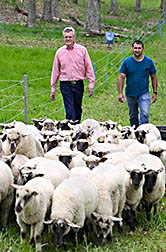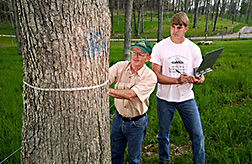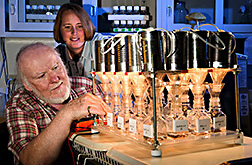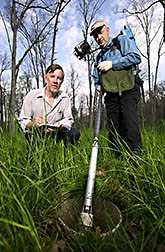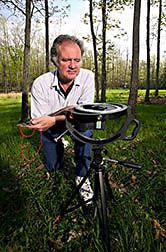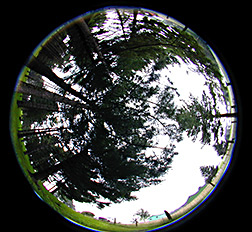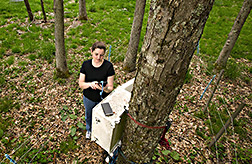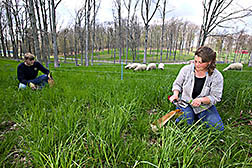A Sylvan Scene in Appalachia
Mixing trees with pastures has benefits
|
|
Soil scientist Charlie Feldhake says that when he arrived in the Appalachian region in 1981, he looked at the wooded, mountainous landscape with only patches of open pasture and realized, “Trees seem best suited to these growing conditions. We should be working with them on farms, not against them,” as local culture then dictated. From that observation sprouted the idea for the ARS silvopasture project.
“Charlie had the imagination and vision to see the potential of agroforestry. We joined in with various disciplines to begin a silvopasture project to make Charlie’s vision a reality,” says Dave Belesky, an agronomist who heads the Appalachian Farming Systems Research Center in Beaver, West Virginia.
Silvopastures are combinations of forages and trees growing together on the same site. Creating them usually involves planting trees in open pastures. But at Beaver, it also means planting forages among thinned stands of mature trees. This technique extends grazing areas into long-unused, mixed-hardwood forests at the edge of pastures. In nature, the meeting of two different landscapes, like fields and woods, creates an “edge effect”—an area where increase in wildlife and plant diversity could occur.
|
|
In 1991, Feldhake planted neat rows of black locust trees into a pasture and let sheep and goats graze there periodically. Since then, the project has expanded to become a dominant focal point of the grazing and soil ecology work at the center, Belesky says. About 80 acres are involved in the silvopasture experiments in a patchwork of forest, open pasture, and silvopasture. Other experiments on black walnut/honey locust silvopastures are under way with collaborators at Virginia Tech University, in nearby Blacksburg, Virginia.
A Sensible Strategy
“It made sense to me to work trees into farming here,” Feldhake says. “Most Appalachian farms contain a substantial amount of forested area. As I was looking at the strengths and weaknesses of farming here compared to the Midwest, I realized that corn and soybean farmers have to struggle with losing nutrients like nitrogen and phosphorus. But forested areas seem better able to retain nutrients. Small-scale farmers can grow forage and other plants as understory crops with less need to fertilize.” That’s important, he explains, because it reduces costs and overcomes difficulties of applying lime and fertilizer on rugged land.
“Also, Appalachian farmers need to diversify their crops for other sources of income, to balance things out if one source fails. They can earn money from sales of extra trees for lumber or firewood. Trees can be planted in pastures for nuts, fruit, or even animal fodder in the case of honey locust and its nutritious pods.”
Sheep as Tillers and Planters
Feldhake, Belesky, and Jim Neel—an ARS animal scientist—are in the fourth year of raising lambs on oak silvopastures. They start each April with 4-month-old lambs that weigh 50 to 60 pounds. Their study compares traditional open pasture to silvopasture. So far, they’ve found that the lambs gain weight at about the same rate and end up at a similar market weight—about 100 pounds—on both systems.
They also found that some important forage plants differ in nutritive value when grown in silvopasture, with some plants doing better under moderate shade than in open pasture.
The results are encouraging, because the silvopasture system “provides the potential to expand the amount of available acreage and the amount of forage produced. This gives farmers more flexibility in providing forage to grazing livestock, even in dry years,” Feldhake says.
Because the rugged Appalachian terrain often precludes using farm machinery—not to mention the trees that are in the way—the research team used sheep, and some goats, to control existing understory plants and prepare the land for seeding mixes of orchardgrass, white clover, tall fescue, or other forage plants.
|
|
Hay and corn were scattered around the site to help keep the animals moving and fed. As they moved around, the sheep disturbed the forest litter and buried the forage seeds with their hooves, essentially helping to plant their own silvopastures. The sheep were kept on the sites until the forage seeds sprouted.
Erlend Mathias, an agronomist who has been with the research center since its beginnings at Morgantown, West Virginia, says sheep are really good at preparing the soil for seed planting because they move around so much. “They always think the grass is greener on the other side,” he says, “so they’re always on the move when grazing.”
Mathias put a great deal of effort into establishing the sites, averaging one per year for the past 5 years.
“We thin out the trees based on size and spacing and remove dead and damaged ones,” Mathias says. “We’ve had success with all our silvopastures. We haven’t had to replant the forage—except for a new silvopasture last year, when wet weather delayed planting. We may have to reseed that one.”
The silvopastures are designed carefully—from the size of the trees to the amount and quality of light allowed to reach the forest floor. The sites have instruments to monitor light, soil temperature, wind speed, precipitation, and soil moisture.
“We apply lime and phosphorus as indicated by soil tests and sometimes come back to apply nitrogen fertilizer, if needed,” says Mathias. But the exact fertilizer needs of silvopastures are not known yet. So ARS microbiologist Tom Staley is defining the types and amounts of phosphorus occurring in silvopastoral soils to help define phosphorus fertilizer needs.
Keeping an Eye on Things
While some team members keep a watch on aboveground processes, others are going underground. ARS plant physiologist Rich Zobel has inserted 6-foot-long, clear plastic tubes deep into the soil, at an angle. This allows him to use small cameras to spy on plant roots. He placed the tubes in both silvopasture and open pasture for comparison. Photographs of plant roots are analyzed to determine site and management effects on growth and form.
“There’s a possibility that the trees are helping the shallower grass roots grow by drawing up water and getting it within their reach during drought,” Zobel says.
Other aspects of soil components of the system are under study by ARS colleagues Katherine O’Neill and Jonathan Halvorson, soil ecologists, and biologist Harry Godwin. They measure environmental and biological diversity aspects of silvopasture practices, such as retention of soil carbon and nitrogen, rate of decomposition of forest litter and livestock manure, and effects of insects and small animals on nutrient cycling. They seek to understand how silvopasture functions as a managed ecosystem and how nutrients flow in this complex and novel system.
|
|
Spring Comes Earlier in the Woods
Silvopastures can serve as buffers for seasonal weather extremes. Feldhake’s current research focus is on microclimate effects on pasture productivity. He and colleagues have found that the climate in the partially wooded pastures is markedly different from that found in open pastures.
Spring usually comes earlier in the wooded pastures because the tree canopy bounces back heat radiated from the land and pasture plants. Feldhake heard that idea from a sheep farmer in a mountainous area of France where the terrain is similar to that of Appalachia. He put the farmer’s observation to the test by designing inexpensive thermometers to measure leaf temperature of forage plants.
Feldhake uses a thermocouple on a metal plate attached to a stake, at a cost of a few dollars per sensor. By monitoring data from these—placed in various locations in partially wooded and open pastures over the past 5 years—he found that the French farmer was right: Spring does come about 2 weeks earlier in the partially wooded pastures. Canopy temperature can be up to 16˚F warmer in silvopastures than the temperature in typical open pastures. Feldhake also found that winter—or at least the hard frosts—comes about 2 weeks later in silvopastures. So silvopastures might provide another 4 weeks’ worth of forage growth and grazing time.
Because of the shade and buffering from seasonal weather extremes, the microclimate in the woods may also support more and better forage growth during seasonal extremes. Neel and Belesky are investigating this through continuing research with lambs on oak silvopastures and open pastures about 10 miles east of their lab.
|
|
Differences in Forage Quantity, Quality
The researchers have to be very conscious of light levels in silvopastures. They want to learn, for instance, how forages react to the constantly diffuse light of conifers compared to the scattered patches of light from widely spaced deciduous trees. Tree leaves also filter out certain wavelengths of light, which can vary by tree species, with eventual effects on forage growth and composition.
Researchers in other regions have found that silvopastures with moderate shade had higher yields of tall fescue and orchardgrass than heavily shaded pastures had. “So having just the right amount of light buffering seems to help,” Feldhake says.
Neel found that the forage on silvopastures had more protein than forages on open pasture during the heat of July and August. This indicates that the shade of the trees might have helped maintain forage quality.
“But this can be a mixed blessing,” he says. “Plants grow slower in shade, and too much shade can cause the plants to build up excess nitrogen, which can harm the environment when animals excrete it. It can also lead to a toxic buildup of nitrate in the plants. Too much shade can also lower sugar content of plants. This, together with excess nitrogen levels, can drastically reduce grazing, causing the animals to gain less weight than they should,” Neel says. “We’ve found that you can’t go much higher than 25 percent shade.”
|
|
Then again, in Appalachia, everything has to be rethought for silvopastures. Techniques used on open pasture might not apply in shaded sites, the researchers say. “We’re finding here that most silvopastures can only support about half as many animals per acre as open pasture,” says Neel.
Even so, Mathias believes that silvopastures have a place, “though we still have a way to go in understanding all the advantages and disadvantages,” he says. He thinks silvopastures could give sheep farmers an edge during the heat of summer, when open pasture productivity declines. He knows that for struggling farmers every little bit of home-grown forage helps.
“This project is an excellent example of a multidisciplinary team approach to solving practical land-use questions,” Belesky says. “We obtain fundamental scientific knowledge on a range of important pasture-management topics while the practical information can be used by small-scale farmers in the Appalachian region.”—By Don Comis, Agricultural Research Service Information Staff.
This research is part of Rangeland, Pasture, and Forages, an ARS National Program (#205) described on the World Wide Web at www.nps.ars.usda.gov.
Charles M. Feldhake, David P. Belesky, James P.S. Neel, and Erlend L. Mathias are with the USDA-ARS Appalachian Farming Systems Research Center, 1224 Airport Rd., Beaver, WV 25813-9423; phone (304) 256-2830 [Feldhake], (304) 256-2841 [Belesky], (304) 256-2972 [Neel], (304) 256-2875 [Mathias], fax (304) 256-2921.
"A Sylvan Scene in Appalachia" was published in the August 2005 issue of Agricultural Research magazine.







